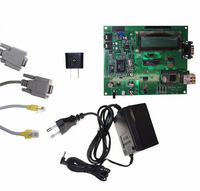ATWEBDVK-02VOIP Atmel, ATWEBDVK-02VOIP Datasheet - Page 12

ATWEBDVK-02VOIP
Manufacturer Part Number
ATWEBDVK-02VOIP
Description
KIT DEV TCP/IP AT89C51RD2 VOIP
Manufacturer
Atmel
Series
@Webr
Datasheet
1.ATWEBDVK-02RC.pdf
(137 pages)
Specifications of ATWEBDVK-02VOIP
Main Purpose
*
Embedded
*
Utilized Ic / Part
AT89C51RD2
Primary Attributes
*
Secondary Attributes
*
Lead Free Status / RoHS Status
Contains lead / RoHS non-compliant
- Current page: 12 of 137
- Download datasheet (2Mb)
Table 4-1.
12
AT89C51RD2/ED2
XTALA1
XTALA2
P2.0 - P2.7
P3.0 - P3.7
P4.0 - P4.7
P5.0 - P5.7
RST
Mnemonic
Pin Description (Continued)
PLCC44 VQFP44
24 - 31
13 - 19
11,
21
20
11
13
14
15
16
17
18
19
10
9
-
-
18 - 25
7 - 13
15
14
10
12
13
11
5,
3
5
7
8
9
4
-
-
Pin Number
10, 13, 16
PLCC68
63, 7, 8,
54, 55,
56, 58,
59, 61,
34, 39,
40, 41,
42, 43,
20, 24,
26, 44,
46, 50,
60, 62,
64, 65
45, 47
53, 57
29
49
48
34
39
40
41
42
43
45
47
30
63, 1, 4, 7
VQFP64
43, 44,
45, 47,
48, 50,
25, 28,
29, 30,
31, 32,
49, 51,
52, 62,
11, 15,
53, 54
34, 36
17,33,
35,39,
42, 46
20
38
37
25
28
29
30
31
32
34
36
21
Type
I/O
I/O
I/O
I/O
I/O
I/O
I/O
O
O
O
O
I
I
I
I
I
I
I
Name and Function
P1.7: Input/Output:
CEX4: Capture/Compare External I/O for PCA module 4
MOSI: SPI Master Output Slave Input line
When SPI is in master mode, MOSI outputs data to the slave peripheral.
When SPI is in slave mode, MOSI receives data from the master
controller.
XTALA 1: Input to the inverting oscillator amplifier and input to the
internal clock generator circuits.
XTALA 2: Output from the inverting oscillator amplifier
Port 2: Port 2 is an 8-bit bidirectional I/O port with internal pull-ups. Port 2
pins that have 1s written to them are pulled high by the internal pull-ups
and can be used as inputs. As inputs, Port 2 pins that are externally
pulled low will source current because of the internal pull-ups. Port 2
emits the high-order address byte during fetches from external program
memory and during accesses to external data memory that use 16-bit
addresses (MOVX @DPTR).In this application, it uses strong internal
pull-ups emitting 1s. During accesses to external data memory that use
8-bit addresses (MOVX @Ri), port 2 emits the contents of the P2 SFR.
Port 3: Port 3 is an 8-bit bidirectional I/O port with internal pull-ups. Port 3
pins that have 1s written to them are pulled high by the internal pull-ups
and can be used as inputs. As inputs, Port 3 pins that are externally
pulled low will source current because of the internal pull-ups. Port 3 also
serves the special features of the 80C51 family, as listed below.
RXD (P3.0): Serial input port
TXD (P3.1): Serial output port
INT0 (P3.2): External interrupt 0
INT1 (P3.3): External interrupt 1
T0 (P3.4): Timer 0 external input
T1 (P3.5): Timer 1 external input
WR (P3.6): External data memory write strobe
RD (P3.7): External data memory read strobe
Port 4: Port 4 is an 8-bit bidirectional I/O port with internal pull-ups. Port 3
pins that have 1s written to them are pulled high by the internal pull-ups
and can be used as inputs. As inputs, Port 3 pins that are externally
pulled low will source current because of the internal pull-ups.
Port 5: Port 5 is an 8-bit bidirectional I/O port with internal pull-ups. Port 3
pins that have 1s written to them are pulled high by the internal pull-ups
and can be used as inputs. As inputs, Port 3 pins that are externally
pulled low will source current because of the internal pull-ups.
Reset: A high on this pin for two machine cycles while the oscillator is
running, resets the device. An internal diffused resistor to V
power-on reset using only an external capacitor to V
output when the hardware watchdog forces a system reset.
CC
. This pin is an
4235K–8051–05/08
SS
permits a
Related parts for ATWEBDVK-02VOIP
Image
Part Number
Description
Manufacturer
Datasheet
Request
R

Part Number:
Description:
KIT DEV TCP/IP AT89C51RD2
Manufacturer:
Atmel
Datasheet:

Part Number:
Description:
KIT DEV TCP/IP AT89C51RD2 REMOTE
Manufacturer:
Atmel
Datasheet:

Part Number:
Description:
KIT DEV TCP/IP AT89C51RD2 WEBCAM
Manufacturer:
Atmel
Datasheet:

Part Number:
Description:
DEV KIT FOR AVR/AVR32
Manufacturer:
Atmel
Datasheet:

Part Number:
Description:
INTERVAL AND WIPE/WASH WIPER CONTROL IC WITH DELAY
Manufacturer:
ATMEL Corporation
Datasheet:

Part Number:
Description:
Low-Voltage Voice-Switched IC for Hands-Free Operation
Manufacturer:
ATMEL Corporation
Datasheet:

Part Number:
Description:
MONOLITHIC INTEGRATED FEATUREPHONE CIRCUIT
Manufacturer:
ATMEL Corporation
Datasheet:

Part Number:
Description:
AM-FM Receiver IC U4255BM-M
Manufacturer:
ATMEL Corporation
Datasheet:

Part Number:
Description:
Monolithic Integrated Feature Phone Circuit
Manufacturer:
ATMEL Corporation
Datasheet:

Part Number:
Description:
Multistandard Video-IF and Quasi Parallel Sound Processing
Manufacturer:
ATMEL Corporation
Datasheet:

Part Number:
Description:
High-performance EE PLD
Manufacturer:
ATMEL Corporation
Datasheet:

Part Number:
Description:
8-bit Flash Microcontroller
Manufacturer:
ATMEL Corporation
Datasheet:










